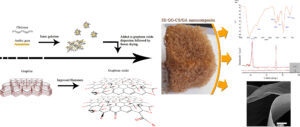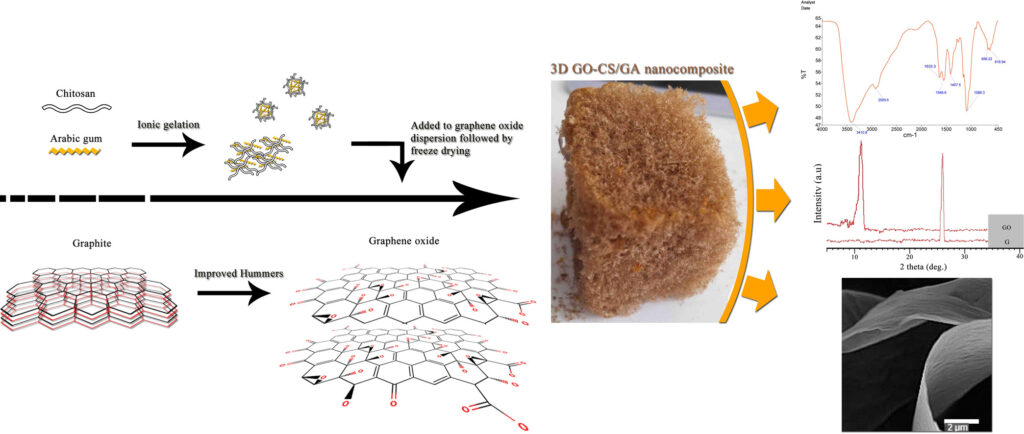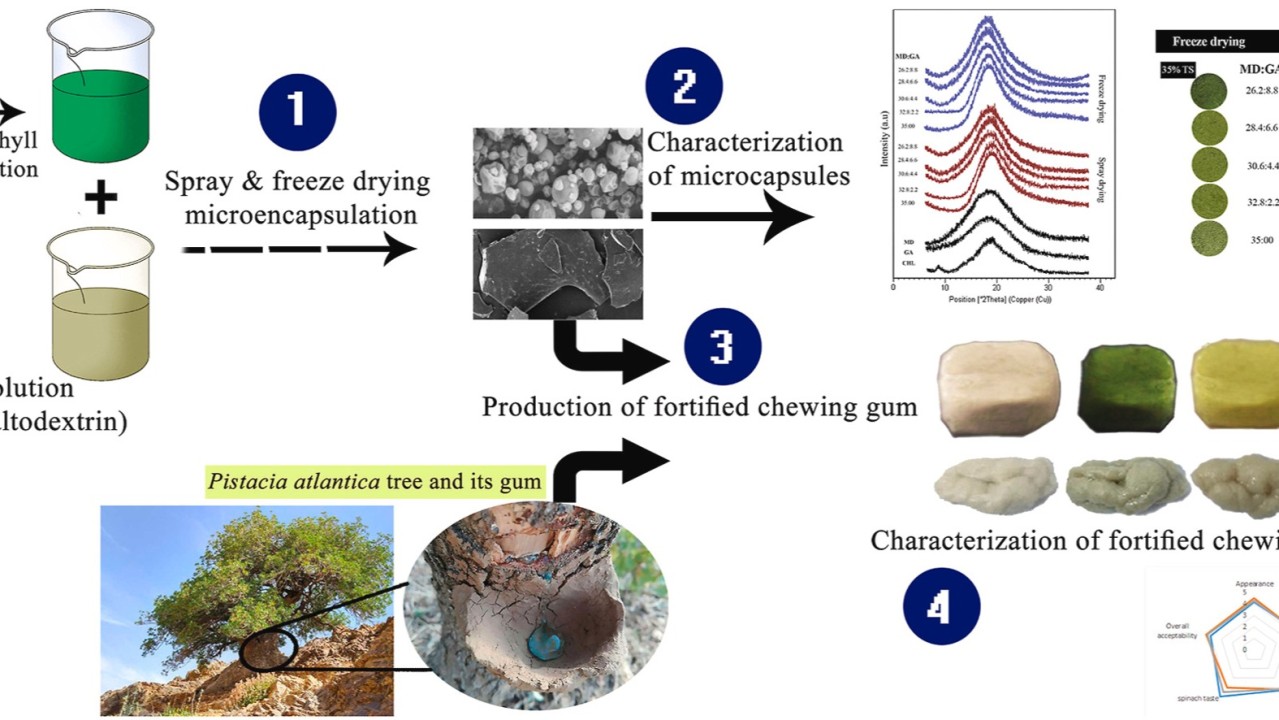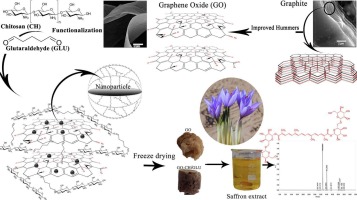By Hamid Rajabi a, Seid Mahdi Jafari a,
Javad Feizy b, Mohammad Ghorbani a,
Seyed Ahmad Mohajeri c
- a
- Faculty of Food Science and Technology, Gorgan University of Agricultural Sciences and Natural Resources, Gorgan, Iran
- b
- Department of Food Quality Control and Safety, Research Institute of Food Science and Technology, Mashhad, Iran
- c
- Faculty of pharmaceuticals, Mashhad University of Medical Sciences, Mashhad, Iran
Received 23 April 2020, Revised 3 June 2020, Accepted 8 June 2020, Available online 10 June 2020, Version of Record 28 June 2020.
Abstract
Although graphene oxide (GO) is a good adsorber, it has a low stability in pure form which can be improved by the development of GO-based composites. In this study, 3D nanostructures with GO, surface-decorated by nanocomplexes of chitosan (CS) and gum Arabic (GA), so called 3D GO-CS/GA nanocomposites were designed. The instrumental analysis confirmed the interaction of complexes with oxygenated functional groups of GO which improved both of d-spacing in 3D sheets by 16%, and GO thickness from 1.0 to 8.1 nm. Also, an unprecedented ~3-fold increase was observed in the surface area of 3D GO-CS/GA compared with single GO. The 3D nanocomposites showed a mesoporous structure with a pore volume of 0.72 cm3/g and a prevailing pore size distribution of about 10 nm. The adjustability of nanocomposite surface charge over pH was another important result. The synthesized nanostructures would be of profound interest for numerous areas including adsorption processes.
Graphical abstract

Introduction
Development of nanoscale-based carbonaceous materials have gained popularity due to their techno-functional, flexibility and charming properties. The prosperous oxidation of pristine graphite results in the formation of expanded lamellar structures, full of oxygenated functional groups in their surface, named graphene oxide (GO). The attractiveness of GO due to possessing a flat structure, high surface area, diversity of functional groups, simplicity and low-cost synthesis method from graphite, motivated the scientists to define tremendous research topics to identify the potential of its application in different fields [1,2]. Also, the needs for specializing GO applications in order to meet predetermined requirements as well as modifying its properties, caused researchers to incorporate different polymers/biopolymers onto the GO surface [3] through covalent/noncovalent bonding with its functional groups; which creates new physicochemical features depending on the weight ratios of GO to polymer, polymer characteristics and synthesis procedure [4].
Accordingly, different polymers/biopolymers have been used to modify GO properties such as chitosan [1,[5], [6], [7]], polyethyleneimine [8,9], polyethylene glycol [10,11], poly(vinyl alcohol) [12,13], gum Arabic [[14], [15], [16]], welan gum [17,18], poly(amidoamine) [19], zeolitic imidazolate frameworks [20], poly(methyl methacrylate) [21], and poly(acrylamide) [22,23]. It has been declared that inclusion of polymers onto GO nanosheets gives rise to modifications toward aggregation prevention [24], improved sorption properties [25], enhanced stability [26,27], improved mechanical and barrier properties [28,29], modification of dispersion behavior and morphology [30], modification of dielectric and thermal properties [27,31,32], and changes in optical properties [7,33,34].
Nanotechnology has opened the door to a whole new world in all fields of science in terms of bringing singular physicochemical properties such as magic surface area. As an example, nanoparticles have received a broad attention during the last decade. In the viewpoint of separation and extraction, nanoparticles could effectively act toward adsorbing analytes of interest through their high surface area and reactivity [[35], [36], [37]].
Several groups of NPs are used in order to functionalize GO including noble and non-noble metal NPs such as Pt, Au and Cu; metal oxide/sulfide NPs such as Fe3O4, MnO2 and SnS2; quantum dots and polymeric/biopolymeric NPs such as polyaniline-poly(4-styrenesulfonate, poly(N-isopropylacrylamid-polyethylene oxide and starch [[38], [39], [40]]. The aims of embedding NPs onto GO sheets can be summarized in three categories of improving structural stability, technological performance and process facilities. In this regard, NPs on GO can play several roles such as inducing a magnetic field, preventing the restacking of sheets, increasing the surface area, and improvement in the catalytic activity and selective/non-selective adsorption of analytes [6,40,41]. When the aim of embedding NPs is improving the technological performance of GO toward selective adsorption of an analyte, polymeric/biopolymeric NPs can be a promising candidate due to the presence of functional groups on their surfaces. The research topic on the using of biopolymeric NPs for GO functionalization is scarce. As an example, Chen et al. [40] conducted a research toward functionalization of GO by starch NPs to adsorb dyes.
The term “Ionic Gelation” (IG) comes from the process in which a complexation occurs between two polymers of polyanions and polycations, resulted in forming structures of micro or nano size, depending on the factors such as pH and the weight ratios of applied polymers [42,43]. IG has gained significant ground in the food and pharmaceutical industry. Chitosan (CS) and gum Arabic (GA) could interact together through this mechanism by their amine and carboxyl groups, respectively. CS, a biodegradable amine rich marine polysaccharide is a popular biopolymer due to its nontoxicity, biocompatibility and low cost production method through deacetylation of chitin [44]. The protonation of CS amine groups in acidic aqueous medium causes its dispersion and solubilization, making it very reactive when exposed to negatively charged molecules [45]. GA, a complex-structure exudate polysaccharide is well known for its biodegradability, biocompatibility and water solubility [46]. Possessing high –COOH density of GA brings about its tendency to bond with polycations, and formation of complexes with nano/microsized structures based on the weight ratios of polyanion to polycation and also pH [5].
To the best of our knowledge, no report has been published about green decoration of GO nanosheets by nanoparticles of CS/GA. The aims of the present study were categorized in three stages: (1) preparing nanoparticles of CS/GA by IG followed by determining the optimum weight rations and pH; (2) synthesis of GO from pristine graphite by improved Hummers’ method; (3) fabricating 3D nanostructure of GO decorated with nanoparticles of CS/GA followed by its characterizing via field emission scanning electron microscope (FE-SEM), transmission electron microscopy (TEM), atomic force microscopy (AFM), X-ray diffraction (XRD), and Fourier-transform infrared (FTIR) spectroscopy. The surface area and pore characteristics of 3D GO were assessed via Brunauer-Emmett-Teller (BET) and Barrett–Joyner–Halenda (BJH) methods, respectively.
Section snippets
Materials and methods
Chitosan was purchased from Sigma-Aldrich (USA) with the following characteristics: ([poly(D –glucosamine)], average viscosity 110 mPas (1% solution in 1% acetic acid: degree of deacetylationn, DDA > 75%), and low molecular weight (MW 50–190kDa); graphite powder (99.99%), sulfuric acid (95–98%), potassium permanganate (99%), phosphoric acid (85%), and hydrogen peroxide (30wt% in water) were purchased from Sigma-Aldrich (USA). Spray-dried GA (MW = 295–1860 kDa, MC = 5.2 wt%) and ethanol (99%)
Characterization results of CS-GA nanocomplexes
The aim of present work in the first stage was to identify the optimum formulation for CS-GA NPs in terms of successful bonding with GO sheets, by considering a high negative surface charge of GO. The results of physicochemical assessment of NPs produced via complexation of different weight ratios of CS and GA at two levels of pH are presented in Table 2 and Fig. 1. The lowest value of mean diameter was recorded for CS10GA5pH4 (Table 2), maybe as a result of higher and stronger attractive
Conclusion
No report has been launched toward embedding green NPs of complexed CS-GA on GOs. The instrumental analysis in this work revealed the evidence toward confirmation of successful bonding of NPs and soluble complexes with GO. The interactions involved in the formation of NPs and soluble complexes as well as those for ternary nanocomposites were ionic interaction and hydrogen bonding. Arising new absorption peak in FTIR, increasing the GOs d-spacing in XRD from 0.87 nm in GO alone to 1.01 nm in 3D
Role of authors
Hamid Rajabi did the experiments and wrote the 1st draft of manuscript.
Seid Mahdi Jafari designed the framework of this study, finalized the manuscript and take responsibility of submissions and publishing stages.
Javad Feizy was the advisor for chemical instrumental analysis.
Mohammad Ghorbani contributed to discussion of instrumental data.
Seyed Ahmad Mohajeri was the advisor for the synthesis of GO and complexed biopolymers.
Declaration of competing interest
Authors declare no conflicts of interest regarding this paper.
Acknowledgment
This study was financially supported by the Iran National Science Foundation (INSF), Grant No. 96011404.
References (75)
- H. Joz Majidi et al.
Investigating the best strategy to diminish the toxicity and enhance the antibacterial activity of graphene oxide by chitosan addition
Carbohydr. Polym.
(2019) - H. Joz Majidi et al.
Fabrication and characterization of graphene oxide-chitosan-zinc oxide ternary nano-hybrids for the corrosion inhibition of mild steel
Int. J. Biol. Macromol.
(2020) - G.-Q. Huang et al.
Effect of coacervation conditions on the viscoelastic properties of N, O-carboxymethyl chitosan–gum Arabic coacervates
Food Chem.
(2017) - S. Kumar et al.
Physiochemical and optical properties of chitosan based graphene oxide bionanocomposite
Int. J. Biol. Macromol.
(2014) - Y. Shi et al.
Design of reduced graphene oxide decorated with DOPO-phosphanomidate for enhanced fire safety of epoxy resin
J. Colloid Interface Sci.
(2018) - Q. Zhao et al.
Stable graphene oxide/poly (ethyleneimine) 3D aerogel with tunable surface charge for high performance selective removal of ionic dyes from water
Chem. Eng. J.
(2018) - A. Baek et al.
Polyethylene glycol-engrafted graphene oxide as biocompatible materials for peptide nucleic acid delivery into cells
Bioconjug. Chem.
(2018) - C. Zhang et al.
The surface grafting of graphene oxide with poly (ethylene glycol) as a reinforcement for poly (lactic acid) nanocomposite scaffolds for potential tissue engineering applications
J. Mech. Behav. Biomed. Mater.
(2016) - C. Liu et al.
Graphene oxide reinforced alginate/PVA double network hydrogels for efficient dye removal
Polymers
(2018) - H. Liu et al.
Surface modified graphene oxide/poly (vinyl alcohol) composite for enhanced hydrogen gas barrier film
Polym. Test.
(2016) - D. Silvestri et al.
Production of electrospun nanofibers based on graphene oxide/gum Arabic
Int. J. Biol. Macromol.
(2019) - R.K. Layek et al.
Noncovalent functionalization of reduced graphene oxide with pluronic F127 and its nanocomposites with gum Arabic
Compos. Part B
(2017) - D. Kang et al.
Bio-inspired composite films with integrative properties based on the self-assembly of gellan gum–graphene oxide crosslinked nanohybrid building blocks
Carbon
(2015) - J. Ahmed et al.
Mechanical, thermal, structural and barrier properties of crab shell chitosan/graphene oxide composite films
Food Hydrocoll.
(2017) - H. Liu et al.
Effect of polyethyleneimine modified graphene on the mechanical and water vapor barrier properties of methyl cellulose composite films
Carbohydr. Polym.
(2018) - Y. Cui et al.
Gas barrier performance of graphene/polymer nanocomposites
Carbon
(2016) - Z. Chen et al.
Role of reduced graphene oxide in dielectric enhancement of ferroelectric polymers composites
Appl. Surf. Sci.
(2019) - S. Kumar et al.
Synthesis, physicochemical and optical properties of bis-thiosemicarbazone functionalized graphene oxide
Spectrochim. Acta A Mol. Biomol. Spectrosc.
(2018) - N.M. Mahmoodi et al.
Zeolite nanoparticle as a superior adsorbent with high capacity: synthesis, surface modification and pollutant adsorption ability from wastewater
Microchem. J.
(2019) - C. Yang et al.
Densely-packed graphene/conducting polymer nanoparticle papers for high-volumetric-performance flexible all-solid-state supercapacitors
Appl. Surf. Sci.
(2016) - S. Bao et al.
One-pot synthesis of magnetic graphene oxide composites as an efficient and recoverable adsorbent for Cd (II) and Pb (II) removal from aqueous solution
J. Hazard. Mater.
(2020) - S.C. de Moura et al.
Encapsulating anthocyanins from Hibiscus sabdariffa L. calyces by ionic gelation: pigment stability during storage of microparticles
Food Chem.
(2018) - H. Rajabi et al.
Chitosan-gum Arabic complex nanocarriers for encapsulation of saffron bioactive components
Colloids Surf. A Physicochem. Eng. Asp.
(2019) - M. Hosseinnejad et al.
Evaluation of different factors affecting antimicrobial properties of chitosan
Int. J. Biol. Macromol.
(2016) - H. Li et al.
Fatty acid and quaternary ammonium modified chitosan nanoparticles for insulin delivery
Colloids Surf. B: Biointerfaces
(2018) - H. Rajabi et al.
Retention of saffron bioactive components by spray drying encapsulation using maltodextrin, gum Arabic and gelatin as wall materials
Food Hydrocoll.
(2015) - S. Ghasemi et al.
Nanoencapsulation of d-limonene within nanocarriers produced by pectin-whey protein complexes
Food Hydrocoll.
(2018) - C.C. Sipoli et al.
Scalable production of highly concentrated chitosan/TPP nanoparticles in different pHs and evaluation of the in vitro transfection efficiency
Biochem. Eng. J.
(2015) - Q. Hu et al.
Formation of redispersible polyelectrolyte complex nanoparticles from gallic acid-chitosan conjugate and gum arabic
Int. J. Biol. Macromol.
(2016) - H. Espinosa-Andrews et al.
Interrelationship between the zeta potential and viscoelastic properties in coacervates complexes
Carbohydr. Polym.
(2013) - M. Beck-Broichsitter et al.
Biophysical investigation of pulmonary surfactant surface properties upon contact with polymeric nanoparticles in vitro
Nanomedicine
(2011) - O. Harush-Frenkel et al.
A safety and tolerability study of differently-charged nanoparticles for local pulmonary drug delivery
Toxicol. Appl. Pharmacol.
(2010) - A. Alishahi et al.
Chitosan nanoparticle to carry vitamin C through the gastrointestinal tract and induce the non-specific immunity system of rainbow trout (Oncorhynchus mykiss)
Carbohydr. Polym.
(2011) - P. Li et al.
Synthesis, characterization, and bactericidal evaluation of chitosan/guanidine functionalized graphene oxide composites
Molecules
(2017) - L. Dai et al.
Characterization of Pickering emulsion gels stabilized by zein/gum arabic complex colloidal nanoparticles
Food Hydrocoll.
(2018) - D. Han et al.
Preparation of chitosan/graphene oxide composite film with enhanced mechanical strength in the wet state
Carbohydr. Polym.
(2011) - X. Shen et al.
Wrinkling in graphene sheets and graphene oxide papers
Carbon
(2014)
There are more references available in the full text version of this article.
Cited by (19)
-
Preparation of superhydrophobic, green, and eco-friendly modified polylactic acid foams for separation oil from water
2023, International Journal of Biological MacromoleculesCitation Excerpt :Chitosan (CS) is a carbohydrate biopolymer that can be obtained from the shell of crustaceans such as crabs, and shrimps by the deacetylation reaction of chitin [28]. CS is prepared in different forms such as foam, gel, film, and fibers [29]. The nCS as one of the modification agents of polymer foam has the characteristics of non-toxicity, biocompatibility, high biodegradability, abundance, cheapness, and structural flexibility.
-
Chitosan-gum Arabic nanofiber mats encapsulated with pH-sensitive Rosa damascena anthocyanins for freshness monitoring of chicken fillets
2022, Food Packaging and Shelf Life -
Bio-nanocomposites of graphene with biopolymers; fabrication, properties, and applications
2021, Advances in Colloid and Interface Science -
Recent advances in the effective removal of hazardous pollutants from wastewater by using nanomaterials—A review
2023, Frontiers in Environmental Science -
Tuning polylactic acid scaffolds for tissue engineering purposes by incorporating graphene oxide-chitosan nano-hybrids
2021, Polymers for Advanced Technologies




